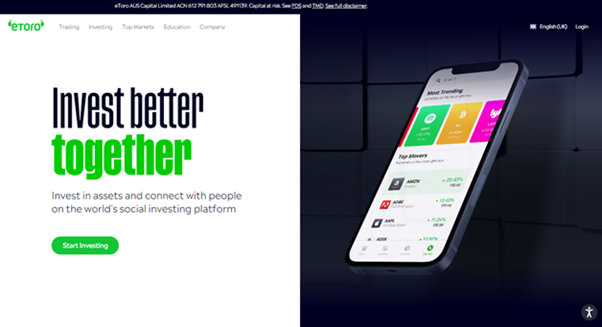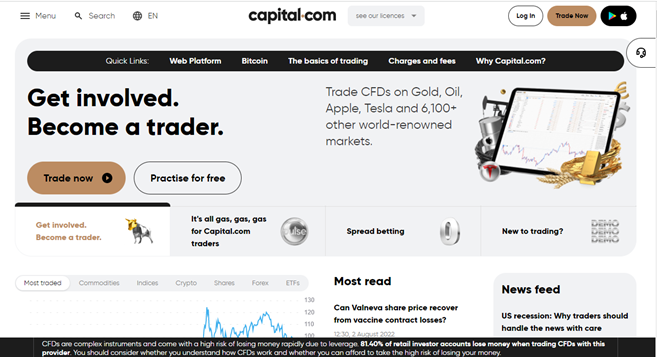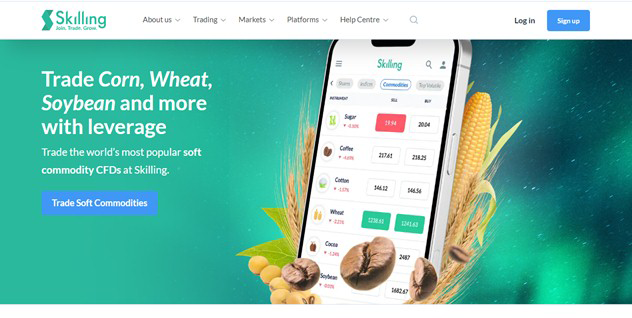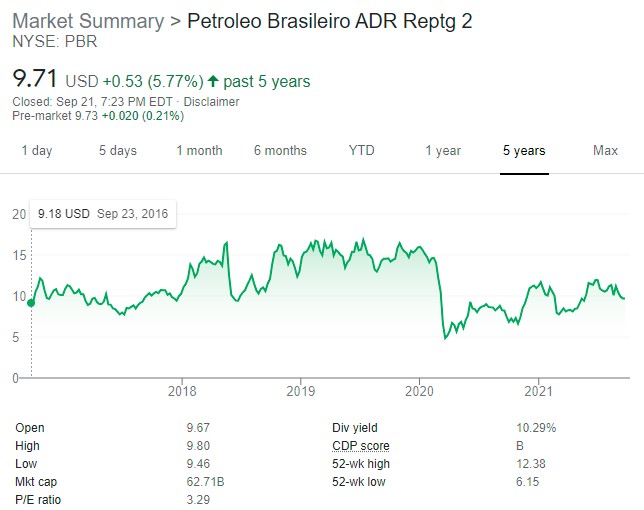How to buy Petrobras stocks in 2025

Petróleo Brasileiro S.A. or simply Petrobras is a state-run Brazilian petroleum company that is involved in exploration, production, and refining of oil, supply of natural gas, generation of electricity, and transportation, storage & trading of POL (petroleum oil lubricants). The Brazilian company operates two basins, 15 refineries, 48 terminals and pipeline networks, 20 thermal power plans, and over 5,500 production wells.
The company’s American Depository Receipts (ADRs) trades on the New York Stock Exchange (NYSE) under the ticker PBR. Its stock is also listed on the stock exchanges of Brazil (B3) and Spain (BMAD). This article guides you on how to buy Petrobras stock, explains why you should buy it, and discusses everything you need to know about the company.
How to Buy PBR Stocks in 5 Easy Steps
-
1Visit eToro through the link below and sign up by entering your details in the required fields.
-
2Provide all your personal data and fill out a basic questionnaire for informational purposes.
-
3Click 'Deposit', choose your favourite payment method and follow the instructions to fund your account.
-
4Search for your favourite stock and see the main stats. Once you're ready to invest, click on 'Trade'.
-
5Enter the amount you want to invest and configure your trade to buy the stock.
Best Reviewed Brokers to Buy Petrobras Stocks
1. eToro

eToro is one of the most prominent social investment networks, with a mission to improve investors' knowledge and activity regarding finance. Since its inception in 2007, eToro has become the premier investment platform for novice and experienced traders, with a user base of over 17 million. You can read our full eToro review here.
Security and Privacy
When choosing an investment platform, security is among the biggest factors to consider. Since eToro is regulated by the Financial Conduct Authority (FCA) and the Cyprus Securities and Exchange Commission (CySEC), you can be assured that your funds and personal details are secure. Furthermore, eToro SSL encrypts all submissions to safeguard against hackers trying to intercept confidential information. Finally, the platform has two-factor authentication (2FA) to ensure the users’ accounts are safe.
Fees & Features
Both inexperienced and seasoned investors can take advantage of eToro's extensive library of cutting-edge trading methods. For instance, beginners in trading can take advantage of CopyTrading available on eToro as it allows them to mimic the actions of more experienced traders. Those with trading experience will be glad to find that eToro provides access to many markets, such as stocks, currencies, and cryptocurrency, all from one platform. Also, eToro is a commission-free service. However, the platform charges a monthly fee of £10 for inactivity to promote active trades on the platform.
| Fee Type | Fee Amount |
| Commission Fee | 0% |
| Withdrawal Fee | £5 |
| Inactivity Fee | £10 (monthly) |
| Deposit Fee | £0 |
Pros
- Copy trading feature
- SSL encryption to protect users' information
- Trading is commission-free
Cons
- Limited customer service
2. Capital.com
Capital.com, which originated in 2016, is an excellent multi-asset broker. With over 5 million users, it has established itself as a low-cost platform with low overnight fees, tight spreads, and 0% commission. You can read our full Capital.com review here.
Security and Privacy
Capital.com is an FCA, CySEC, ASIC, and NBRB-licensed corporation dedicated to providing the most effective trading experience in the world. It shows that users' data is secured and hidden on Capital.com, since the site follows stringent criteria to achieve this goal. Capital.com takes client data security seriously, and one way it does this is by complying with the PCI Data Security Standards.
Fees & Features
Capital.com offers a wide variety of no-cost brokerage services. Its financial policies are transparent. Any fees you incur will be made clear before you pay them. Capital.com's principal costs come from spread charges, which are often low compared to competitors. The broker's mobile trading app features an AI-powered tool that gives clients personalized trading information by employing a detection algorithm. In addition, Capital.com's multilingual customers can get in touch with a representative via email, phone, or live chat.
| Fee Type | Fee Amount |
| Deposit Fee | £0 |
| Commission Fee | 0% |
| Inactivity Fee | £0 |
| Withdrawal Fee | £0 |
Pros
- Efficient email and chat support
- MetaTrader integration
- Commission-free trading
Cons
- Majorly restricted to CFDs
3. Skilling

Skilling is a multi-asset broker with significant growth. The broker offers excellent trading conditions regarding platform features and products available to experienced traders. Skilling now provides Forex, CFD, Stock, and cryptocurrency trading six years after its inception to individual investors. You can read our full Skilling review here.
Security and Privacy
When looking for a broker like Skilling, it is essential to check the broker's regulatory standing. Skilling is administered by the Financial Conduct Authority (FCA) and the Cyprus Securities and Exchange Commission (CySEC). In addition, the money that traders deposit into their Skilling accounts is held in a completely independent financial institution. For maximum safety, Skilling only uses top-tier financial institutions for this purpose. Tier 1 capital is the industry benchmark for measuring a bank's soundness.
Fees & Features
Skilling does not charge commissions for trading equities, indices, or cryptocurrencies. The platform charges Spreads which vary based on the share, but are typically very reasonable. Skilling offers two distinct account options for FX and metals CFD trading. The Standard Skill account has significantly larger spreads but no commissions. The Premium account charges commissions on spot metal and FX CFD trades for decreased spreads. Additionally, Skilling provides a demo account, mobile applications, and a trade assistant.
| Fee Type | Fee Amount |
| Commission Fee | £0 |
| Withdrawal Fee | Varies |
| Inactivity Fee | £0 |
| Deposit Fee | £0 |
Pros
- Great platform choice
- Demo accounts
Cons
- High Spreads
- Service is unavailable in many countries, including the US and Canada.
Everything You Need To Know About Petrobras
You should thoroughly understand a company, including its history, strategy, revenue sources, recent performance, among many other details, before buying its stock. The in-depth knowledge about the company will enable you to base your buying or selling decision on solid grounds rather than on speculation or a hunch.
Petrobras History
Petrobras was established on the 3rd of October, 1953, in Rio de Janeiro, Brazil, as a state-owned company under the leadership of Brazilian president Getúlio Vargas. In 1961, the company founded its first refinery (REDUC) in Rio de Janeiro that has an installed capacity of 239,000 bbl/d or 38,000 m3/d, with the ability to refine 55 products.
In 1968, the company built its first mobile drilling rig that discovered offshore oil reserves in the continental shelf of the Sergipe state of Brazil. The petroleum giant discovered the first field, Garoupa, in Campos Basin in 1974 off the Brazilian coast.
In the following two years, Namorada and Enchova fields were also discovered in the Basin. It made its first pre-salt discovery off the Brazilian coast in 2007, and the output of which increased to 300,000 barrels per day in 2013 to 1 million barrels per day in 2016.
What Is Petrobras’ Strategy?
Petrobras’ management has approved a five-year strategic plan in 2020 for 2021-2025 that is based on five key pillars: maximise the return on capital employed, reduce the cost of capital, attain high efficiency at low costs, ensure meritocracy by adopting economic value added or EVA-based compensation programme, and strengthen the culture of safety, health & environment.
As part of the strategic plan for 2021-2025, the company allocated $46 billion to the E&P segment and over 70% or $32 billion of the allocated funds to the pre-salt assets. The strategic allocations aim to maximise the investments in deep and ultra-deepwater which have lower lifting costs that result in higher returns on investment.
The company allocated $13 billion for the renovation of Campos Basin, which will be used to explore 14 blocks acquired from the ANP and drill four more exploratory wells in 2021. Further, the company has allocated funds of $3.7 billion for the upkeep of the 13 refineries.
In the gas and power segment, the company plans to invest in the natural gas processing unit and Route 3 - the company’s third pre-salt gas route - to extract high quantities of natural gas from the pre-salt production. The route is expected to start operating by the end of Q2 2022. The company plans to allocate 13 new production systems to deepwater or ultra-deepwater projects by 2025.
How Does Petrobras Make Money?
Petrobras business areas include refining, transporting, exploration, production, distribution, and marketing crude and oil products. The company derives most of its revenues from selling crude oil, oil products and natural gas. The company also operates internationally, with reserves in South America, refineries in Texas, the U.S., and many exploration blocks in the Gulf of Mexico.
In Brazil, Petrobras produces 99% of the total global oil production. The petroleum company has exploration rights for roughly 60,248 km2, of which 17% constitute onshore basins while the remaining 83% offshore basins.
As of 2021, the share of the Concession Agreements model in the company’s oil and gas production stands at around 68%, whereas the share of Rights Agreements and Production Sharing Agreements stands at 15% and 17%, respectively.
How Has Petrobras Performed in Recent Years?
Petrobras stock price had remained at approximately the same level in the past five years. Starting from the 23rd of September 2016 till the 21st of September 2021, it only inched upward by 53 cents or 5.77% during the period. The stock touched the highs of $16 multiple times between 2016 and 2021. It also plummeted to its five-year low of $4.85 inMarch 2020, during the peak of the pandemic.

Source: Google Finance
Where Can You Buy Petrobras Stock?
You can buy Petrobras stock by opening an equity or stock account with a stockbroker. Some brokers offer different types of accounts, such as cash account, margin account, CFD account, and other specialised investment accounts. Opening a cash account allows you to buy stocks using your own money, whereas a margin account allows you to buy stocks on credit using borrowed funds from your broker.
Petrobras Fundamental Analysis
Fundamental analysis involves interpreting various financial metrics of a stock to know its actual or intrinsic value in relation to its market price. Value investors carefully study the financial statements of a company and extract useful information before investing in its stock. The fundamental factors that most investors analyse include P/E, revenue, earnings, earnings-per-share, dividend yield, and cash flow, among others.
Petrobras’ Revenue
Revenue means the monetary value of the goods or services a company sold during a period. The revenue serves as the primary cash flow for a company, and its success depends on the growth of its revenue. Companies usually have different business and revenue segments, and the management aims to derive revenue from multiple sources to stabilise and diversify the company’s earnings.
You can find the revenue figures on the income statement that is issued as part of the financial statements of the company. Petrobras reported revenue of $15.6 billion in Q2 2021 (Jan-Mar 2021), of which $9.4 billion was generated by sales of oil products and $1.9 billion was generated by sales of gas, electricity, and other services. Revenue from exports amounted to $4.3 billion during the quarter.
Petrobras’ Earnings-per-Share
The earnings-per-share or EPS metric shows the earnings available for each outstanding share. The measure can be calculated by dividing the net profit by the average number of shares outstanding during a period.
For example, if a company generated a net profit of $100 million and had an average of 10 million outstanding shares during the period, the EPS would be $10 per share ($100 million/ 10 million). If a company reports net loss for a period, the metric will show loss per share or negative earnings per share. Petrobras reported a gain per share of $0.01 for Q2 2021.
Petrobras’ P/E Ratio
The price-to-earnings ratio denotes the market price of a share with respect to its earnings per share. The metric is calculated by dividing the stock’s market price by its earnings per share. For example, a company’s share is trading at $20 per share and has earnings per share of $2, the P/E ratio would be 10x.
The P/E ratio of 10x means that the stock’s market price is ten times its earnings per share. A stock with a high P/E ratio could mean that the stock is overvalued, but you should confirm your analysis by comparing its P/E ratio with other stocks from the industry. The P/E ratio is calculated on a trailing 12-month (TTM) basis, which takes into account the earnings per share of the previous 12 months and the current market price of the stock. So, the P/E ratio changes with the change in the market price of the share.
An extension of the P/E ratio is the price to earnings-growth or PEG ratio, which is calculated by dividing the stock’s P/E ratio by its annual EPS growth. This tells us how much an investor is paying per unit of earnings growth. A stock with a low PEG ratio mostly means the stock is undervalued, and a stock with a high PEG ratio often denotes an overvalued stock.
As of September 22, 2019, Petrobras’ P/E ratio stood at 3.37x.
Petrobras’ Dividend Yield
Dividends are cash payouts by a company to its shareholders from its profits. The board of directors of a company decide whether to pay out dividends or retain the earnings to advance the company’s business.
You need to hold the company’s shares before the ex-dividend date to be eligible for getting dividends declared by the company. On the ex-dividend date, a stock’s price gets reduced as the new buyers don’t get the dividends and want to buy them at a discount to account for the lost dividends.
Dividend yield determines the percentage of the stocks’ market price that the company pays annually as dividends per share. For example, a stock with a dividend yield of 5% means that the stock paid out 5% of its market price annually as dividends per share. If a stock’s market price is $10 and the stock paid out $2 per share last year as dividends, the dividend yield would be 20% ($10/$2)x100. Investors prefer stocks with high dividend yields, as such stocks provide investors with a higher rate of return if they buy the stock at its current price.
Petrobras declared it paid out $0.2929 per share on May 06, 2021, and $0.6215 on the 1st of September 2021. The stock’s dividend yield (per year) at its market price of $10 per share is 9%.
Petrobras’ Cash Flow
The free cash flow measures the cash available to a company after it pays its operating expenses and capital expenditures. The free cash flow can be used by a company to pay out dividends or carry out any other activity to enhance its business.
A higher free cash flow allows a company to use its own resources to fund its new projects without relying on external financing. You should analyse a company’s cash flow statement to know the amount of cash available and how much it utilised and generated its cash from operating, financing, and investing activities.
As of March 31, 2021, Petrobras had cash & cash equivalents of $11.96 billion.
Why Buy Petrobras Stocks?
Petrobras is one of the largest companies in Brazil in terms of the amount of revenue, assets, and profits. While you can base your buying decision on analysing different financial metrics of the stock, there are plenty of other reasons to buy it:
- The company has historically paid healthy dividends with a decent dividend yield near 10%, which makes it a preferred choice for dividend investors.
- Investing in Petrobras can expose you to the Brazilian energy market, which can help you diversify your portfolio while giving you a chance to generate higher returns.
- The company has successfully recovered from the pandemic-related shocks and has generated a recurring EBITDA growth rate of 34% in Q1 2021. The margin also increased by 55% in the first quarter of 2021. Free cash flows stood at $5.6 billion in the quarter - and the annual debt reduction of $18.3 billion and quarterly reduction of $4.6 billion.
Expert Tip on Buying Petrobras Stock
“ Petrobras stock had been trading in the range of $10 and $15 for the most part between 2016 to 2021. However, the stock doubled after the stock hit its five-year low in March 2020 during the peak of the pandemic. You can consider buying the stock on dips if you want to buy it for the long term to generate capital gains along with dividends. The stock also provides opportunities for day traders if you follow the oil industry closely as the oil prices and industry developments can result in short-term price movements. ”
5 Things to Consider Before You Buy Petrobras Stock
If you plan to buy Petrobras stock, you should consider the following important tips before buying it.
1. Understand the Company
You need to understand the company’s business model, revenue sources, ongoing major and future projects, financial metrics, among other details. Also, you should have a thorough understanding of the company’s operations and the industry in which it operates, which will help you foresee the risks and opportunities while allowing you to make accurate and timely buy or sell decisions.
2. Understand the Basics of Investing
You can fare well in the market if you have even the basic understanding of investing. One of the basic principles of investing is to create a well-diversified portfolio that has stocks from different sectors with high growth potential. If you are a short-term or intraday trader, you should use risk management techniques to ensure that you don’t risk more than 1% or 2% of your account. Risk management also involves opening the right trade size so that your risk is kept at manageable levels.
3. Carefully Choose Your Broker
Selecting the appropriate stockbroker can make a difference in your trading performance. Your broker should ideally provide you with the following features:
- Gives you access to an advanced trading platform that offers you mobile trading functionality and can be used across all operating platforms.
- Charges low commissions and spreads, which can lower your trading costs.
- Should be a regulated broker so that your risk of getting defrauded can be reduced.
- Gives you popular easy fund deposit and withdrawal methods.
- Provides technical analysis tools and allows you to place different types of orders and implement risk management techniques.
4. Decide How Much You Want to Invest
You should refrain from investing all your money in a single stock or asset class as your investment returns would depend on the performance of a single asset, which can expose you to a high degree of risk. The appropriate method that most fund managers adopt is to select disparate stocks that would spread the overall risk of your portfolio across different stocks.
5. Decide on a Goal for Your Investment
Your investment strategy depends on your investment goal. For example, if you want to earn a 100% return on your investment in a year, you would have to adopt a high-risk strategy and might have to use leverage to amplify your returns. However, if you set a reasonable goal of achieving the market returns, you can do so by assuming a moderate risk strategy. There will be a risk-return tradeoff, which means that if you want to achieve higher returns, you will have to take on higher risk, and vice versa.
The Bottom Line on Buying Petrobras Stocks
Petrobras is one of the largest companies in Brazil and has featured in the Fortune Global 500 that ranks global companies based on the amount of revenues. The company has set up a strategic plan with key performance indicators that aims to attain higher operational efficiency at lower costs.
The firm reported encouraging half-yearly results in 2021. The sheer number of exploration blocks, refineries, basins, and other assets has swelled its balance sheet, and the company has over $5.6 billion of free cash flows in Q1 2021. The stock also provides a dividend yield close to 10%, which offers an attractive return on your investment on dividends alone.
If you want to invest in Petrobras stock, you should open your account with a stockbroker. Most brokers allow you to open your account online by filling out an online form and uploading the scanned images of your identification documents, such as your government-issued ID card and your proof of residence. Your documents will be created within three business days if your documents are correct, after which you can fund your account and start buying your favourite stocks.
If you want to explore other interesting stocks like Petrobras, you can read many other guides on our website that provide detailed information on a range of companies. The guides will facilitate you in finding the appropriate stocks for investment.
Frequently Asked Questions
-
Petrobras stock trades on the B3 stock exchange and Bolsa de Madrid stock exchange, while its American Depositary Receipts (ADRs) are traded on the New York Stock Exchange. So, you can buy its stock by opening an account with any stockbroker that is affiliated with any of the three stock exchanges.
-
Petrobras stock gives you exposure to the Brazilian oil market, provides you with a decent dividend yield, and diversifies your investment portfolio.
-
You can hold Petrobras stock for the long-term to realise capital gains as well as get the dividends paid by the company.
-
You should note down factors that influence the Petrobras stock in particular and other E&P stocks in general. Also, you should keep a close watch on the international oil prices that can influence the stock price of Petrobras. Any major development in the industry can also act as a catalyst and may move stocks constituting the industry.
-
The company’s operations are mostly concentrated in Brazil, and the government has the controlling interest in the company, which means that the company is influenced by the market conditions, political environment, and government policies. The company is also exposed to volatility in the prices of oil, gas and POL products internationally, which can impact its revenues.
-
The major sources of Petrobras include revenues from sales of crude oil, oil products and natural gas.






